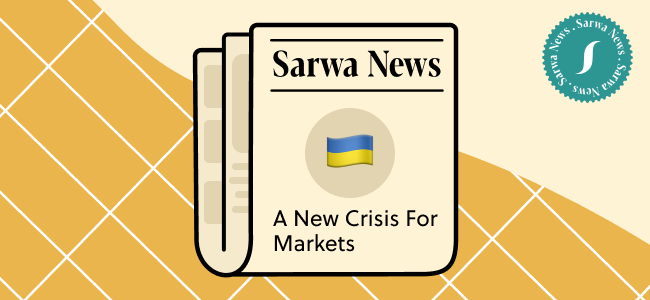Developments of the Ukraine-Russia crisis is the largest geopolitical and military escalations we’ve seen of the past few years. Events such as these are known to occur every now and then, and have had implications on global markets, more specifically on the short term.
Let’s have a look at what has happened, the recent developments, and a little bit about what investors could do about it.
What is happening?
Russia officially launched an invasion of Ukraine. This comes after months of political and military escalations that resulted in a heated standoff between Russia and the west, making a diplomatic approach less likely as time went on.
Earlier this week, Russian president Putin recognised the independence of Luhansk and Donetsk, two pro-Moscow regions in the east of Ukraine. This has yielded a large reaction from the western side.
After that declaration, a series of sanctions have been communicated; the US and UK targeted financial institutions, banks and oligarchs, while the European Union focused on the 351 lawmakers who were in favor of the separation of both these regions, as well as Russian assets located in the EU.
One interesting sanction was Germany pausing the approval of Nord Stream 2, an $11 billion pipeline that directly connects it to Russia. This came as a surprise, as the project was originally designed to double the amount of gas destined for Europe’s largest economy.
How have markets reacted?
Focusing on the US, the S&P500 has entered correction territory, dropping more than 10% since its early January peak, with both the Dow and Nasdaq showing similar downward trends.
Historically, markets haven’t shown a clear and well defined pattern following geopolitical crises. Below are a few instances of such events. Let’s look into how the U.S. markets for example reacted to these:
- Following the start of World War I in 1914, the Dow dropped more than 30%. After a six-month close of the stock market, the Dow rose 88% in 1915, which represents the largest yearly increase to date. Taking the whole war period into account (from 1914 to 1918), the Dow rose in excess of 40%, averaging around 9% per year.
- Moving forward to World War II, the Dow index rose over 10% the week following the start of conflicts. The day after the Pearl Harbor attacks, markets were down around 3%, but losses were recovered within a month. Throughout the second world war (1939 to 1945), the Dow index rose over 50%.
During the largest two wars in contemporary history, the US stock market grew over 100%.
- After the attacks of 11 September 2001, stocks dropped over 15% for two weeks, adding to the already existing effects of the dotcom bubble. The losses incurred after this event were more than offset in the following two months.
- The US stock market rose over 2% the day after the 2003 US invasion of Iraq, and ended the year with a 30% robust performance.
There seems to be a clear pattern when it comes to geopolitical and military conflicts: There are no rules of thumb! Market reactions have differed by time and extent, and can even be counterintuitive. One main reason for that is the various contexts of these escalations, as well as their inherent implications, and whether these will remain regional, or spill over to the international stage.
When discussing the current conflict, the main effect on the Western camp will be on a commodity level. Russia supplies 40% of Europe’s, and 10% of the global natural gas. So further escalation could lead to a lower supply, leading to an increase in worldwide energy bills. In a time where inflation is already well-present, this adds more fuel for officials, such as the Fed, to ensure that the economy’s pace is adjusted.
How should investors react?
Looking back, military tensions and upswings have had short term effects on global markets, without any lingering repercussions. Given that periods following conflicts are highly volatile, investors should maintain their long term approach to investing, without basing decisions on short-lived and uncertain market conditions.
Below are a few best practices to keep in mind:
- Stay calm, composed and disciplined
Engaging in speculation and short-term emotional trading activities have historically led to a loss in wealth. Having a systematic approach when it comes to investing has shown to have a positive impact on your performance. You may be tempted to ‘go with your gut’ in the heat of the moment. Research has shown over and over again, that staying the course when you have a sound plan in place is the smartest way to grow wealth. So don’t let these notifications push you to make rash decisions.
If you haven’t started to invest yet, and you find it daunting to jump in now, an efficient and easy way to start is by adopting a Dollar-Cost Averaging approach. It which allows you to separate emotions from investment decisions.
- Maintain a diversified portfolio
Diversification has been preached over the years, and is attributed to setting the foundations for a robust investment strategy, which has proven to lower your overall risk, while maximizing long-term growth.
- Seize the opportunity
Market downturns can be a good opportunity to lower average purchase price for some; if you have the right risk appetite, and some idle capital sitting in a low interest bank account, drops due to short term fluctuation provide an interesting opportunity to put this amount at work.
- Review Risk Profile
Passive investing is meant to be a worry-free, autopilot style of putting your money to work without the day-to-day hassle. If short term volatility is causing you some concern, it might well be the case that the risk exposure adopted is not the most appropriate for you. While maintaining a long term focus is essential, it is also important to consider your risk tolerance and ability to weather fluctuations, and proactively assess whether this exposure fits your investment goals.
